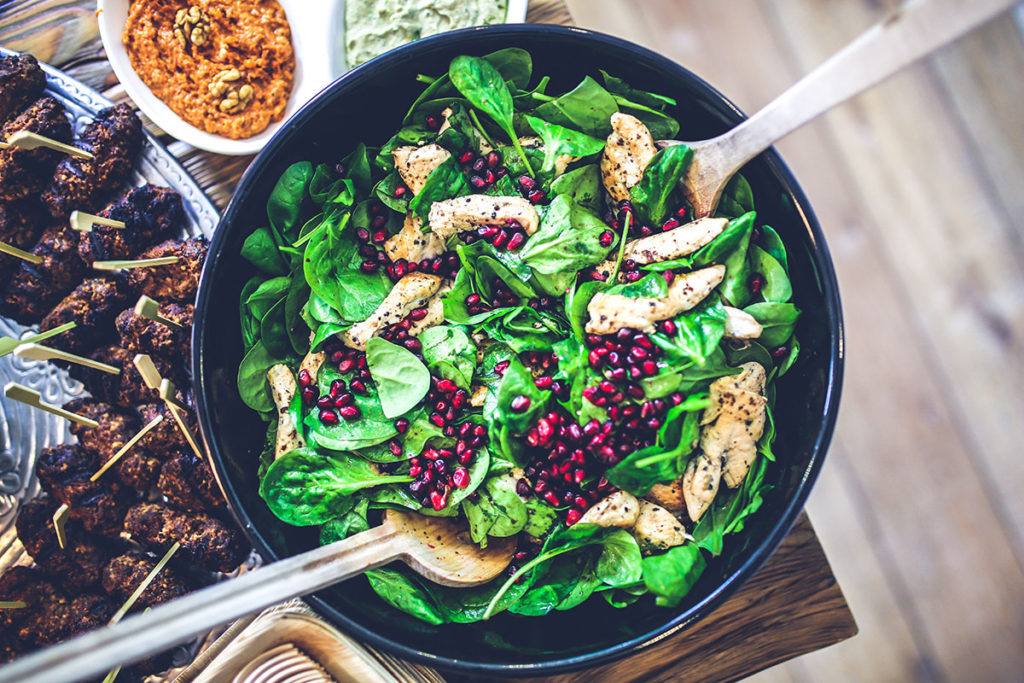Salads have been around for a long, long time – the word itself first appears in the 14th century, associated with the old custom of salting vegetables during the Roman era.
We’ve come a long way since then. In American culture, salads are often served as the side to a larger and more filling entrée. They’ve even made their way into the fast food industry, sitting at around $6.79 for a full-sized salad at affordable and quick to service franchises.
Although not documented, salads have also had a long history with the social struggle for weight management and control. They’re often associated with the word “diet,” which today has a somewhat negative connotation due to the up rise of body positivity.
Fortunately salads have secured themselves at seat at the table with their ability to be healthy, filling, palate cleansing, and satisfying all in one. No longer is it just about dieting – or even health. In this new day and age, salads are often a main dish that surprise and please the diner. Whether made at home or ordered at a restaurant, this dish’s versatility is impressive. But there’s a lot of myth to the nature of the salad, and we’re here to discuss them, along with some tips and tricks to incorporating them into your diet.
- The greener, the better. But it needs to be the right kind of green. For example, iceberg lettuce is considered a green, but it’s mostly water-dense with fewer nutrients than its counterpart, romaine.
If you’re not a fan of the lack of flavor and crunch from romaine lettuce, there are always other options. Sprouts are a great source or nutrients with a fun texture.
In general, the rule is, the darker the green, the more nutrients. Any green food can be a source of antioxidants, phytonutrients (for boosting immune systems), low glucose, and low calories.
We can get even specific by telling you that green vegetables such as collards are rich in vitamin K and have been found to improve bone health. But you can keep it simple, unless you’re looking for specific nutrient-dense foods to add to your diet – just go green.
- Salads are great options at fast food joints, yes, but skip the dressings. That’s most likely where your highest sources of calories, fat, and sugar are coming from. Many companies use high fructose corn syrup, which has been connected to obesity, diabetes, and more. They also use cheap vegetable oils that can lead to inflammation.
If you simply can’t go without dressing, check out a few homemade recipes online. They’re quick, easy, and fresh. And definitely better for your body.
- Throw in a ton of ingredients. By definition, the basic salad consists of lettuce, tomato, and cucumber. But you’re not getting enough of out those three vegetables, and really, they aren’t going to fill you up long-term. If you want your salad to be a meal, look for nutrient and protein dense salads. And switch it up. No one wants to be bored eating the same thing over and over!
Check out our list of ingredients below to add some pep to your salad, as well as some protein to your diet.
- Salads are for women. Not true.
Yes, they frequently pop up in dieting crazes as a quick way to lose weight. But not everyone wants to lose weight – what about individuals striving to meet a muscle goal, or get toned?
Salads are for them too.
It’s all about what you put in them. A salad made the right way can have multiple protein sources and anywhere from 800-1,000 calories. Chances are, if done correctly, you can lose fat while gaining muscle. Of course salads aren’t the only thing that you’ll need for that kind of transformation – look into workouts tailored to your body type, and foods that may be causing inflammation and bloat in your diet.
- Not all salads are the same. They don’t all incorporate lettuce or greens in general as the main base.
Check out quinoa or tabbouleh (sometimes spelled tabouli) salads, for example. The latter is a vegetarian salad often making use of parsley, tomato, onion and bulgur. With additional seasonings such as lemon juice and mint, it’s a filling but cleansing salad great as a main course or side.
Quinoa salads are served similarly, vegetable-heavy with quinoa as the base grain and served cold. They’re great with peppers for an added crunch and have the additional benefit of being full of protein, iron, and fiber.
Salad Ingredient Options
Greens
- Kale
- Spinach
- Cabbage
- Broccoli stems (they’re actually delicious on their own, as a snack!)
- Snap and sugar peas
- Green beans
- Pak/Bok choy
- Arugula
- Sprouts
Protein
- Chickpeas
- Chicken
- Salmon
- Beef
- Eggs
- Cheese
- Quinoa
- Edamame
- Tuna
Healthy fats
- Almonds
- Walnuts
- Avocados
- Pumpkin seeds
- Sunflower seeds
Miscellaneous
- Berries
- Peppers
- Roasted beets
- Carrots
- Tomato
- Apples
- Oranges

